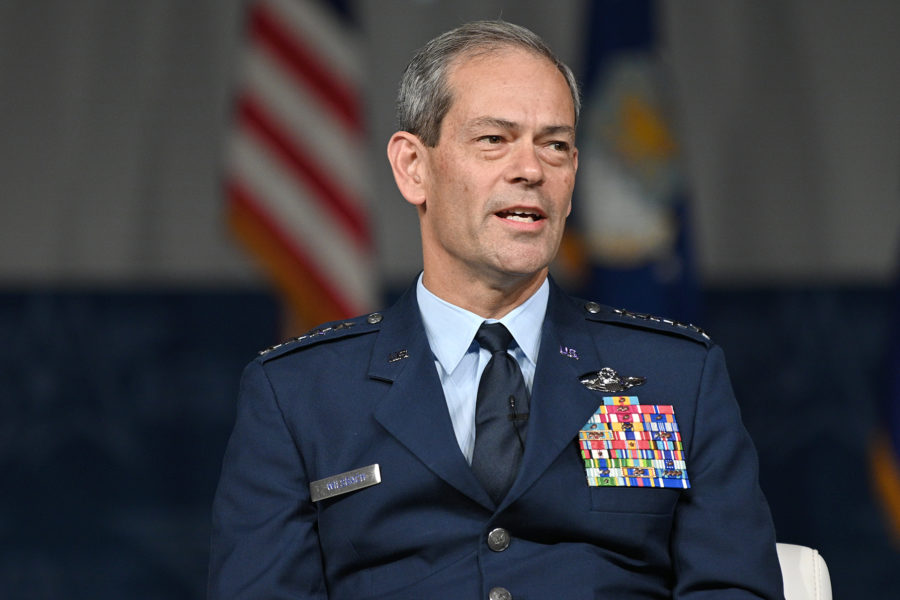Chinese pilots are risking “disaster” with repeated unsafe intercepts of American planes operating in the Pacific, the top U.S. Air Force general in the region said Sept. 11.
“We do fly a lot close to China,” Gen. Kenneth S. Wilsbach, commander of Pacific Air Forces, told reporters at AFA’s Air, Space, & Cyber Conference. “It’s not uncommon for U.S. military aircraft to be intercepted 10 times a day.”
For the most part, the intercepts—which the U.S. military stresses occur in international airspace—are “safe,” Wilsbach said.
Sometimes, however, there are incidents the Pentagon deems risky. The U.S. and many of its allies have taken to publicly identifying some of these incidents, seemingly trying to shame the People’s Liberation Army for operating their aircraft and vessels recklessly. China has a different view.
“When we call them out on these unprofessional, unsafe [intercepts], they’re not willing to have a discussion,” Wilsbach said. “We don’t have that kind of conversation. They blame it on us.”
China claims most of the South China Sea, over which American surveillance aircraft such as USAF RC-135s routinely fly, as its territory.
“Their typical response is, ‘This is your fault because this wouldn’t have happened if you weren’t here,’” Wilsbach said. “Now, let’s just get to the gist of the problem, which is what they’re saying is they don’t want us to exercise the same right that they have to be in international airspace.”
Wilsbach said the U.S. does not take issue with the broad premise of its aircraft possibly being intercepted. NORAD aircraft often intercept Russian aircraft in the Alaska Air Defense Identification Zone (ADIZ), an early warning buffer that extends beyond U.S. airspace. The U.S. military typically stresses those incidents do not violate American sovereignty.
“All we’re asking them to do is just execute safely and professionally,” Wilsbach said. “You can intercept. That’s your right to intercept, just like we do when we have aircraft flying inside of our air identification zones. So do it safely, do it professionally, and everybody will be OK. We won’t have a miscalculation. We won’t have a disaster.”
Wilsbach, speaking broadly about Chinese pilots’ capabilities, said he “wouldn’t think that any of them have prowess like an American fighter pilot,” though he did not cite Chinese aviators’ skills as a safety concern.
“They are not in the same category as what we are trained to,” Wilsbach added.
The U.S. is particularly concerned about the actions of Chinese aircraft because of a lack of high-level communication between the two sides. Military-to-military channels have largely been frozen since Secretary of Defense Lloyd J. Austin III met his then-counterpart last November.
Since that meeting, tensions in the region have only grown between the U.S. and China. A Chinese jet came within a few yards of U.S. Air Force RC-135 over the South China Sea in December, and in February, an F-22 Raptor shot down a Chinese surveillance balloon that transited the continental U.S. U.S. officials have stressed they want communication to avoid escalation.
“It’s really important that the most senior folks can talk to each other as quickly as possible when something happens,” said Dr. Mara Karlin, who is performing the duties of deputy undersecretary of defense for policy, at a Defense Writers Group Event in August. “So Secretary Austin keeps asking for that.”
The often opaque nature of decision-making by the Chinese Communist Party and its People’s Liberation Army under leader Xi Jinping makes it difficult for the U.S. to judge intentions without interactions, experts note.
“We have been trying really hard to set up communication channels and they have not been enthusiastic about those,” Karlin added. “That’s really problematic.”
China insists U.S. sanctions prevent a meeting between Chinese Defense Minister Li Shangfu and Austin, though U.S. leaders say that is not the case. China’s Defense Ministry also insists military-to-military talks have “not stopped.”
In a meeting that occurred after Karlin’s comments, the head of U.S. Indo-Pacific Command Adm. John Aquilino spoke to Chinese military officials at a defense forum in Fiji last month. But overall, substantive talks remain limited.
A previous encounter between U.S. and Chinese aircraft turned deadly and led to a diplomatic crisis. A Chinese fighter and a U.S. Navy EP-3 reconnaissance plane collided in 2001, resulting in the temporary detention of U.S. personnel after they were forced to make an emergency landing in China. The Chinese pilot was killed.
China’s unwillingness to engage in substantive talks or establish lines for discussion in a crisis, in particular, creates concern for regional commanders like Wilsbach when incidents occur.
“That’s concerning to me because some of these could be very close to a disaster,” Wilsbach said.
